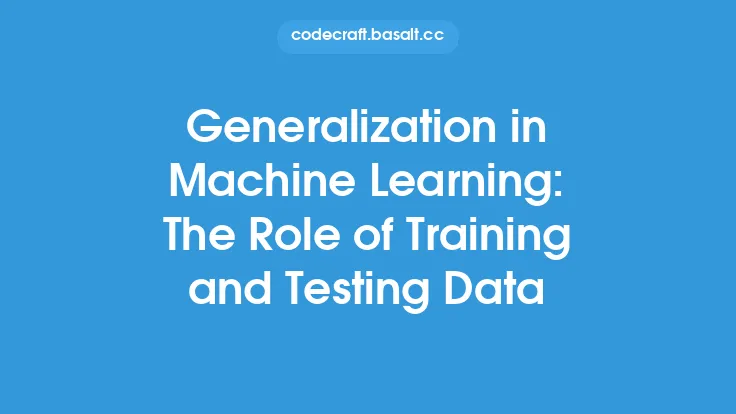Machine learning has become an integral part of modern technology, with applications in various fields such as computer vision, natural language processing, and predictive analytics. The machine learning lifecycle involves several stages, including data preparation, model selection, training, and deployment. However, one of the most critical stages in this lifecycle is model evaluation. Model evaluation is the process of assessing the performance of a machine learning model to determine its accuracy, reliability, and effectiveness. In this article, we will delve into the role of model evaluation in the machine learning lifecycle and explore its importance, techniques, and best practices.
Introduction to Model Evaluation
Model evaluation is a crucial step in the machine learning lifecycle because it helps to ensure that the model is performing as expected and making accurate predictions. The goal of model evaluation is to estimate the performance of a model on unseen data, which is critical for real-world applications. There are several reasons why model evaluation is essential, including:
- Ensuring accuracy: Model evaluation helps to ensure that the model is making accurate predictions and is not overfitting or underfitting the training data.
- Comparing models: Model evaluation allows for the comparison of different models and selection of the best-performing model.
- Identifying biases: Model evaluation helps to identify biases in the model and data, which is critical for ensuring fairness and reliability.
- Improving performance: Model evaluation provides insights into the model's performance, which can be used to improve its accuracy and reliability.
Techniques for Model Evaluation
There are several techniques used for model evaluation, including:
- Holdout method: The holdout method involves splitting the available data into training and testing sets. The model is trained on the training set and evaluated on the testing set.
- Cross-validation: Cross-validation involves splitting the available data into multiple folds and training and evaluating the model on each fold.
- Bootstrapping: Bootstrapping involves creating multiple samples of the data with replacement and evaluating the model on each sample.
- Walk-forward optimization: Walk-forward optimization involves training and evaluating the model on multiple subsets of the data, with each subset representing a different time period.
Metrics for Model Evaluation
There are several metrics used to evaluate the performance of machine learning models, including:
- Accuracy: Accuracy measures the proportion of correct predictions made by the model.
- Precision: Precision measures the proportion of true positives among all positive predictions made by the model.
- Recall: Recall measures the proportion of true positives among all actual positive instances.
- F1 score: The F1 score is the harmonic mean of precision and recall.
- Mean squared error: Mean squared error measures the average squared difference between predicted and actual values.
- Mean absolute error: Mean absolute error measures the average absolute difference between predicted and actual values.
Best Practices for Model Evaluation
There are several best practices for model evaluation, including:
- Using multiple metrics: Using multiple metrics to evaluate the performance of a model provides a more comprehensive understanding of its strengths and weaknesses.
- Using cross-validation: Cross-validation helps to ensure that the model is not overfitting or underfitting the training data.
- Using a holdout set: Using a holdout set helps to ensure that the model is not overfitting the training data and provides an unbiased estimate of its performance.
- Evaluating on multiple datasets: Evaluating the model on multiple datasets helps to ensure that it is generalizing well and not overfitting to a specific dataset.
- Monitoring performance over time: Monitoring the performance of the model over time helps to identify any changes in the data distribution or concept drift.
Challenges in Model Evaluation
There are several challenges in model evaluation, including:
- Class imbalance: Class imbalance occurs when one class has a significantly larger number of instances than the other classes, which can make it difficult to evaluate the model's performance.
- Noise and outliers: Noise and outliers in the data can make it difficult to evaluate the model's performance and may require additional preprocessing steps.
- Concept drift: Concept drift occurs when the underlying data distribution changes over time, which can make it difficult to evaluate the model's performance and may require additional techniques such as online learning.
- Lack of labeled data: Lack of labeled data can make it difficult to evaluate the model's performance, which may require additional techniques such as unsupervised learning or semi-supervised learning.
Conclusion
Model evaluation is a critical stage in the machine learning lifecycle, and its importance cannot be overstated. By using various techniques, metrics, and best practices, machine learning practitioners can ensure that their models are performing as expected and making accurate predictions. However, model evaluation is not without its challenges, and practitioners must be aware of these challenges and take steps to address them. By doing so, they can develop reliable and effective machine learning models that can be deployed in real-world applications.





